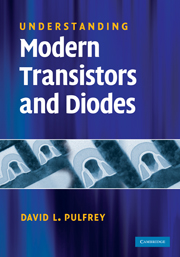Book contents
- Frontmatter
- Contents
- Preface
- 1 Introduction
- 2 Energy band basics
- 3 Electron and hole concentrations
- 4 Thermal equilibrium
- 5 Charge transport
- 6 np- and Np-junction basics
- 7 Solar cells
- 8 Light-emitting diodes
- 9 HBT basics
- 10 MOSFET basics
- 11 HJFET basics
- 12 Transistor capacitances
- 13 Transistors for high-speed logic
- 14 Transistors for high frequencies
- 15 Transistors for memories
- 16 Transistors for high power
- 17 Transistors for low noise
- 18 Transistors for the future
- Appendices
- Index
5 - Charge transport
Published online by Cambridge University Press: 05 June 2012
- Frontmatter
- Contents
- Preface
- 1 Introduction
- 2 Energy band basics
- 3 Electron and hole concentrations
- 4 Thermal equilibrium
- 5 Charge transport
- 6 np- and Np-junction basics
- 7 Solar cells
- 8 Light-emitting diodes
- 9 HBT basics
- 10 MOSFET basics
- 11 HJFET basics
- 12 Transistor capacitances
- 13 Transistors for high-speed logic
- 14 Transistors for high frequencies
- 15 Transistors for memories
- 16 Transistors for high power
- 17 Transistors for low noise
- 18 Transistors for the future
- Appendices
- Index
Summary
The picture of charge carriers that should have emerged so far is one of electrons and holes moving through the semiconductor in momentum states. The carriers are continually being generated and annihilated, and they are also frequently scattered to new momentum states via collisions with vibrating atoms, ionized impurities and other carriers. In thermal equilibrium large fluxes are present, but there is no net current. To disturb this equilibrium, and obtain a non-zero net flow of charge, we need to establish some driving force within the semiconductor. Fundamentally, this driving force is a gradient in energy. It can be manifest as a gradient in the potential energy, which is related to the electrostatic potential ψ, and as a gradient in kinetic energy. If each of the n electrons per m3 has a kinetic energy u, the total kinetic energy density W is nu. Gradients in both n and u can produce a current. The main objective of this chapter is to describe and characterize the currents due to each of these three gradients.
The above picture is one of dissipative transport, i.e., one in which the directed momentum of electrons injected into a region from a hemi-Maxwellian distribution, for example, is dissipated by scattering events. If the region is so short that the injected electrons can traverse it without being scattered, then we have ballistic transport.
- Type
- Chapter
- Information
- Understanding Modern Transistors and Diodes , pp. 63 - 90Publisher: Cambridge University PressPrint publication year: 2010



